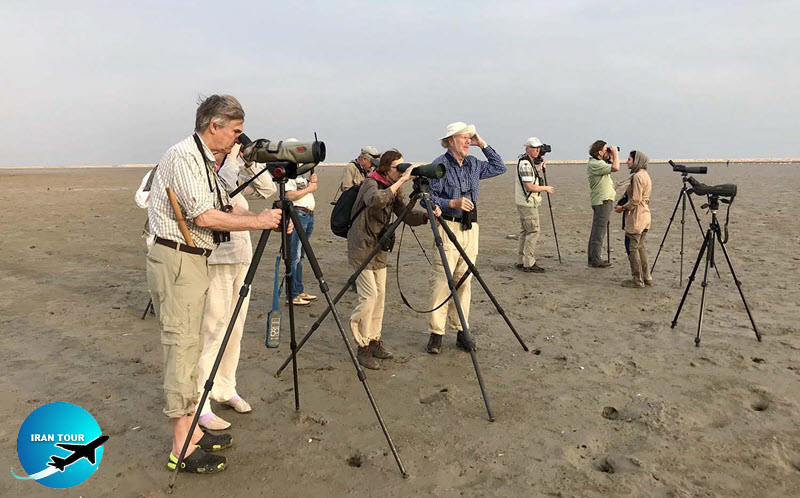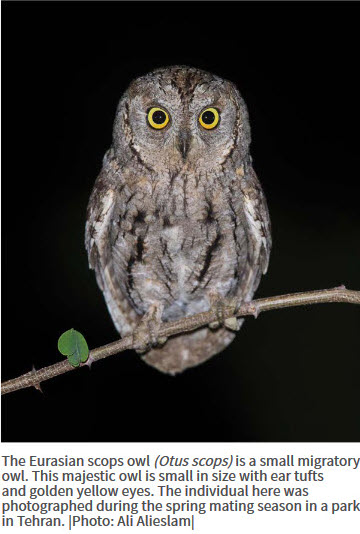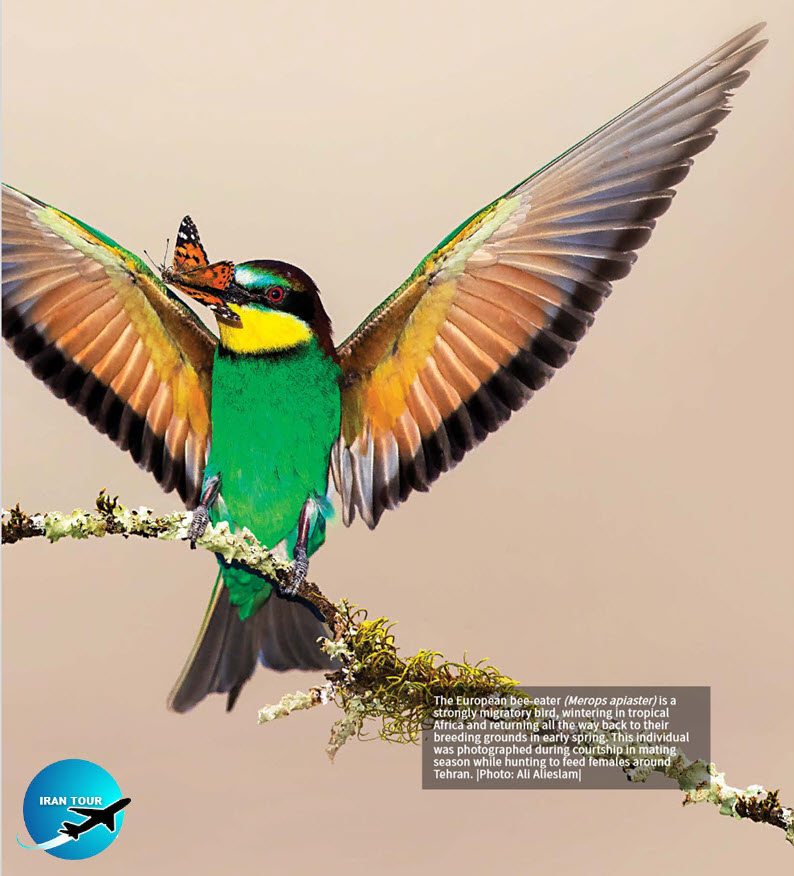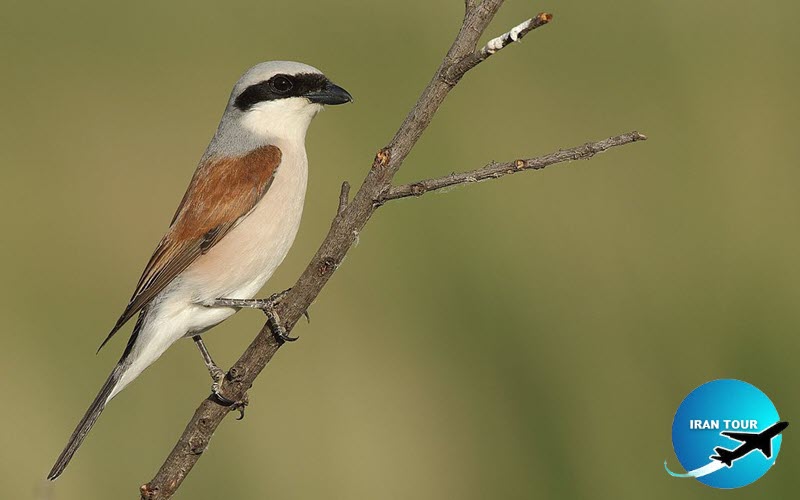Copyright 2020 - 2021 irantour.tours all right reserved
Designed by Behsazanhost
Where Birds Matter
Where Birds Matter
By: Gilgamesh & Ali Alieslam Eco-tours Manager and Birdwatching Tourist Guide
The Pleasure of Birdwatching in the Neighbourhoods of Tehran.
The air belongs to birds, although they are also masters of the land and sea. No other group of animals ventures so high in the air makes its home on every landmass and dives to such great depths below the water. Birds have fascinated us as far back in history as we can explore. Descended from reptiles that developed the ability to fly, birds are among the most mobile of animals.
 |
Early humans painted them on cave walls and etched them on rocks; Egyptians created inlaid images of ibises, geese, and eagles on the walls of their pharaohs' tombs and Persians depicted them in the epic 'miniature art, showing nightingales and roses, either in the most beautiful wall paintings in Isfahan or in the leaves of poetry books, including the Divan of Hafez!
 |
Anyone can study the wonders of birds, from backyard birdwatchers to university scientists. The more we learn, the more fascinating birds become. Imagine over 10,000 different species living in a wide range of habitats, exhibiting diverse plumage of every color, with dazzling arrays of patterns and lifestyles.
Iran is an exceptional destination situated in the heart of the Western and Central Asian Palearctic region. Home to more than 550 different species of birds, including more than 50 endangered or critically endangered species, no other country in the Middle East or West Asia can approach its diversity. Iran's avifauna includes about eighty species of strictly Western Palearctic distribution, which reach their south-eastern limits in the Alborz and Zagros Mountains.
 |
Only a much smaller group of strictly Eastern Palearctic species extends into the north-eastern highlands of the Kopet Dagh Mountains, while many of the birds of the desert interior belong to the so-called Saharo-sindian region desert avifauna, characteristic of the great desert belt which stretches along the southern edge of the Palearctic region from North Africa to Mongolia. By contrast, Iran's south-easternmost province of Baluchistan lies on the borders of the Oriental faunal region and its birdlife has strong affinities with neighboring Pakistan. This Oriental element extends, in an increasingly diluted form, up the coastal plain of the Persian Gulf as far as the Iraq border.
Iran's position as an ornithological crossroads is also evident in the diversity of migratory species that pass through the country. Many migrants pass through Iran on their way from their winter quarters in Africa to breeding grounds in Central and Northern Asia, mostly in Siberia, as well as others on their way from the Indian subcontinent to Western Asia and Europe. This astonishingly high diversity is the result of several facts. The most direct reason is critical.
location of Iran:
It is located where the Palearctic, Afrotropical, and Oriental ecozones meet. The very extensive Palearctic ecozone is divided into eastern and western parts. In the most up-to-date maps for the birds' diversity of the world, Iran is clearly shown at the eastern edge of the western Palearctic region. The western Palearctic ecoregion includes north Africa and the Middle East, both of which have a long-standing reputation for birdwatchers around the world as they are the most accessible megaregions from the heart of Europe. That said, many European birdwatchers who were previously content with seeing birds in their own country, have begun to travel around the edges of the Western Palearctic ecozone in search of the birds most similar to those on their existing 'life list", or even to see birds they may miss to record in their own country!
 |
The other factor contributing to the high diversity of birds in Iran is the considerable variety of habitats available due to the two large bodies of water in the north and south of the country and the two extensive mountain ranges stretching from east to west (Alborz) and northwest to southeast (Zagros). The contrast between the highlands and the lowlands introduced by the mountains and the vast rather arid semi-desert and desert habitats, which together comprise about fifty percent of the country, create a unique range of diverse habitats with many micro-climates and specific habitats ideal for a very diverse range of birds. With the addition of other regions - including internal woodlands, plenty of wetlands, offshore islands, coastal reef, and intertidal areas, the coastal habitats of the Persian Gulf and Makran coasts and the unique Caspian Hyrcanian mixed forest in the north - Iran is a unique region with over 105 Important Bird Areas (IBAs), according to the BirdLife International organization, with regard to the diversity of habitats and climates.
Despite all this ecological diversity, Iran is a very poor country with regard to the unique endemic birds, which are particularly important for birdwatchers who wish to travel to different countries. Indonesia, for example, has over 450 endemic species out of 1750 birds and is, therefore, the destination most populated with birds for birdwatchers; meanwhile, Iran has only one truly endemic bird! It's interesting to know that Cuba, a country ranking almost 10th with regards to the concentration of endemic birds in its territory has twenty-five endemic species out of only about 370 different birds! Neither of these two countries has the variety of climates and diversity of habitats of Iran. So, with regard to the diversity of habitats, a country that has a higher concentration of endemic birds is more appealing to birdwatchers than one with the most diverse habitats. Iran, however, has some relatively important regional birds, which is nevertheless interesting for many birdwatchers around the world. For the outside observer, Iran also seems a bit safer than some of the surrounding countries. That said, Iran can still offer opportunities for veteran birdwatchers looking for the 'mega specialties of the western Palearctic region.
Instead of describing these mega specialties - which are perhaps more fascinating for serious birdwatchers who are very aware of the bird's distribution thanks to the elaborate field guides to the birds of the Middle East and Western Palearctic areas - we are going to look at some of Iran's eye-catching birds. Some of these we have the pleasure of seeing in our own neighborhoods, even in or close to very big cities, such as Tehran.
 |
| Iran's position as an ornithological crossroads is also evident in the diversity of migratory species that pass through the country. Many pass through Iran on their way from their winter quarters in Africa to breeding grounds in Central and Northern Asia, mostly in Siberia, as well as others on their way from the Indian subcontinent to Western Asia and Europe. |
Eurasian Scops Owl The Eurasian scops owl (Otus scops), also known as the European scops owl, is a small migratory owl that breeds in southern Europe and, eastwards, into western and central Asia, including most of the northern parts of Iran. It breeds in open woodlands, parks, and gardens and usually lays 3-6 eggs in a tree hole. Scops owls are active at night, even in the gardens and groves of villages and big parks of cities like Tehran. The bird can be easily detected by its monotonous, repeated call, a single plaintive hoot that carries quite well. This majestic owl is small in size with ear tufts (raised when alert) and golden yellow eyes.
European Roller The European roller (Coracias garrulus) is the only migratory member of the roller family to breed in the
warmer habitats of Europe, the Middle East, Central Asia, and even Morocco in Africa. In Iran, we see them as late spring and early summer breeding visitors, who spend their time in almost every corner of the southern Alborz and all the way south down to the edges of the central desert. The roller favors open and semi-open broken countries, with scattered trees and patches of woodland. It feeds on larger insects, such as grasshoppers, and is famous for its 'rolling' aerial acrobatics!
As a defense strategy, the chick will vomit a foul-smelling orange liquid onto itself in order to deter predators. The smell also warns the chick's parents on their return to the nest.
 |
European Bee-eater
The European bee-eater (Merops apiaster) is a 'near passerine' bird in the bee-eater family that breeds in southern Europe and in parts of North Africa and Western Asia, including Iran. It is strongly migratory, wintering in tropical Africa and returning all the way back to its breeding grounds in early spring. Bee-eaters nest, feed their chicks, and roost communally. Usually seen perched on wires or circling in swallow-like flight, often in small groups, they feed by catching insects (especially bees) on the wing. Male Eurasian bee-eaters court females by presenting the larger insects they catch to the female while eating the smaller ones themselves, thereby cementing the bond between the pair and ensuring high egg quality.
 |
Red-backed Shrike
The red-backed shrike (Lanius Collurio) is a carnivorous passerine bird that visits Iran in early spring to breed in the relatively arid mountainous foothills of the Alborz and Zagros mountains. Like other shrikes, it hunts from prominent perches and impales its captured prey, mostly large insects, sometimes even small rodents and lizards, on thorns or barbed wire, which it uses as a kind of 'larder'. This practice has earned it the nickname 'butcher bird? The shrike has a hooked, hawk-like bill and, like a hawk, it sometimes carries its prey with its feet. This behavior could play a role in mate attraction, as females may choose males that are able to bring abundant food to their chicks. A well-stored larder allows the pair to have better breeding success. Depending on the season, it also feeds on berries in late summer and autumn.
- Details
- Category: What to see in IRAN






